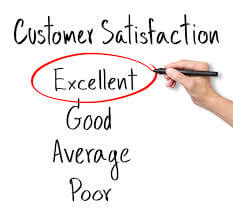I consider myself a student of life.
I always want to be in learning-mode so that I can improve and can continuously add value to those I help: Clients, potential clients, and colleagues, to name a few.
As Carol Dweck notes, in her amazing book, Mindset, that’s the growth mindset—changing, growing, and stretching oneself through application and experience.
I have taken that to an extreme this fall as I have begun a new intensive MBA program.
It’s an adventure that is teaching me to be comfortable in the uncomfortable.
My organization behavior class stresses the differences between organizations setting direction and conducting long-range planning.
Direction Plus Planning Equals Happy Customers
Direction and long-range planning are often used interchangeably, but that is incorrect.
Long-range planning is a process designed to produce orderly results, not change.
Direction setting does not produce plans, it creates vision and strategies which result in change.
While the two activities are separate, they are complements to each other.
An effective planning process serves as a good reality-check on direction-setting activities, and an effective direction-setting process provides clarity and focus to planning activities.
Last month, the Spin Sucks content focused on internal communications.
And this month, the focus is on planning.
So let’s bring the two together: Direction plus planning is the framework for effective internal communications.
But how does direction plus planning end up equalling great customer experiences?
Internal Communications, Planning, and Changing Direction
1. Communication Changes Start at the Top
Communications in an organization are born out of its culture.
A culture is a powerful thing—it can make or break an organization. That’s why any change in culture must start at the top, with the leader in charge.
A change in communications usually is a result of a change in direction. And for these changes to occur, the CEO must lead it and the other executives must support it.
It is a top-down proposition.
The communications change must support the organizational direction and strategy.
Once there is a change in direction, a change in planning typically follows.
Direction setting and planning should always be in alignment.
2. The Entire Organization Must Grow in the Same Direction
Some questions to ask to help you determine if the organization is, indeed, growing in the same direction:
- Are strategic changes being communicated throughout the entire organization?
- How do you ensure this?
- Are the corporate direction, values, and strategies being communicated throughout the organization?
- Does each employee buy into this?
- If your corporation mission isn’t clear, how will your employees understand and commit to it?
- If employees can’t buy into it, how are customers going to buy into it?
Organization leadership must move mission, vision, values, strategies, and communications downstream.
But that’s not enough. Leaders must give employees a reason to buy into the direction and communications.
This starts with building trust through sharing information and creating common ground, leading by example, using common language, and emotionally connecting to employees.
This is not a one-shot deal. Leaders must continuously communicate the organization’s mission, purpose, and values to employees.
If employees see leaders “living and breathing” the organization, they’ll believe and repeat this behavior.
This connection leads to employee motivation.
3. Encourage Employee Participation
Organizations should use tools to establish consistency and the right behaviors.
And, organizations should create tools that build and maintain consistency, tools such as style guides, templates, and common language.
Training employees on effective communications use is the next step. Give your employees opportunities to apply this knowledge.
Their own job functions aside, have employees participate on task forces and other project teams to stretch their skills.
Encourage them to contribute to online forums, or to write for an internal publication or blog.
These steps will enable them to practice what they have learned, which helps them build confidence.
Also, organizations must reward the right behaviors.
Before the rewards, they should make sure metrics for evaluating use and effect of communications are in place.
Then, the organization can align rewards to these metrics.
Create extrinsic rewards such as special recognition, awards, being rewarded in performance appraisals, etc.
Organizations should ensure employees see value in these rewards. If they don’t, create rewards they do find valuable.
When employees see value to these extrinsic rewards, that will lead to intrinsic rewards— when they feel they are adding value to the company, self-confidence will rise, resulting in better work and more engagement.
4. Happy Employees = Happy Customers
When employees believe in and make these actions a part of themselves, they will want to be brand advocates inside and outside the company, adding value to how they interact with fellow employees and with customers, vendors, etc.
In the end, when employees are excited about the brand, they’ll want to share that excitement with everyone—especially customers.
And when customers see and experience happy employees, they aren’t just left feeling warm about your brand. They buy more, and tell their friends and family about it—which is a win for everyone, anyway you look at it.
P.S. Just a reminder that there will be no blog posts tomorrow or Friday. We’ll be back on Monday at our regularly scheduled time. Have a Happy Thanksgiving to our American friends, and a great weekend to everyone else!
